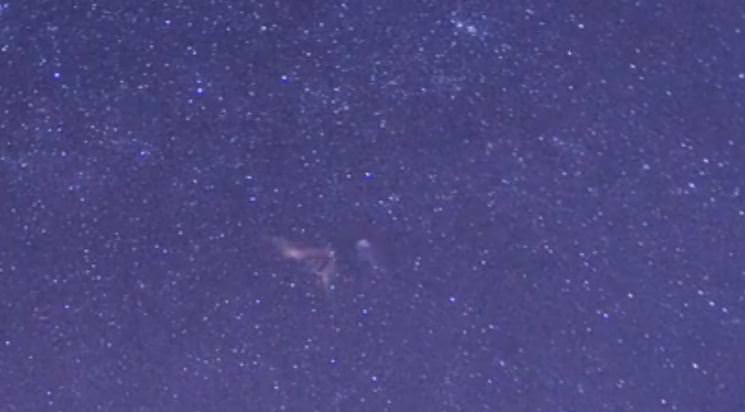Personally, I've never seen anything like this, and photographer and digital artist
Michael K. Chung
said he couldn't believe what he saw when he was processing images he took for a timelapse of the Perseid meteor shower. It appears he captured a meteor explosion and the resulting expansion of a shock wave or debris ring.
"It was taken early in the morning on August 12, 2013 from my backyard in Victorville, CA," Michael told Universe Today via email. "The fade to white is NOT an edit- it is overexposure due to the sun coming up. From what I can tell, the timelapse sequence of the explosion and expanding debris span an actual time of approximately 20 minutes."
Michael said because he shoots at much higher resolution than 720p, he's able to provide two different sequences in this video: one is with the full frame of each capture scaled/reduced and then cropped down to 1280x720, and the other is with the full frame kept at resolution with just the region around the explosion cropped to 1280x720. "I included each sequence twice - once at 24 frames per second and the other at around 12 fps."
Amazing!
Since I've never seen anything like this, I decided to have one of our observing experts provide his opinion. UT writer
David Dickinson
said this is definitely legitimate.
"What cinches it for me is that the meteor was moving in the right direction for a Perseid," Dave told me. "I see Perseus rising to the right, the plane of the Milky Way and Andromeda just above center."
Dave said he has seen several meteors that leave lingering smoke trains. "I usually carry binoculars to examine these," he said, "and saw several examples of this during the 1998 Leonid meteor storm from the desert in Kuwait, one of the most awesome things I've seen. Ever."
Dave concurs, great catch by Michael Chung!
Update:
Daniel Fischer
provided a link to some
imagery and information of the 1998 Leonid observations,
showing persistent trains and more. Daniel also provided a more accurate description of what Michael Chung captured: "a persistent train after a Perseids fireball, being torn apart by upper atmosphere wind shear."
Second update:
We heard from a few more people who also witnessed and captured similar Perseids with persistent trains.
Steve Knight
from the UK also captured some explody-Perseids this year. Take a look at his video below, and at :15 and :19 there are fireballs followed by expanding cloud of debris -- to see it better expand the video and look at the top right part of the screen. Andromeda Galaxy (M31) is visible drifting in from the left.
And Steve also provided animated gifs of the explosions:
Also, Randy Halverson from Dakotalapse, whose work we feature frequently on UT sent a couple of images of persistent trains from meteors, like this one:
[caption id="attachment_104170" align="aligncenter" width="580"]
Meteor with persistent train, taken on October 6th, 2012, from the same spot a similar image was taken a year earlier. Credit and copyright: Randy Halverson/dakotalapse. [/caption]
...and this one of the cloud of debris left from a persistent train:
[caption id="attachment_104171" align="aligncenter" width="580"]
Cloud of debris from a meteor explosion seen near the White River in South Dakota on October 1, 2011. Credit and copyright: Randy Halverson/dakotalapse. [/caption]
Watch his timelapse here, with the explosion taking place at about :53 into the film:
... with
an interesting story
that he set up his equipment to do a timelapse in the same place two years in a row and captured persistent trains both years. To find out more about that, as well as get more info on persistent trains, P
hil Plait wrote this article about it.
There's also an animated gif of an exploding Perseid from
astromel
on Flickr
here.
2013 Perseids Meteor Shower: Meteor Explosion from Michael Chung on Vimeo.
 Universe Today
Universe Today
